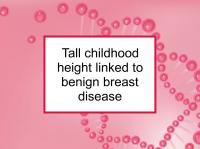A new study has reported that thin girls who experience a rapid growth spurt (leading to tall stature in adulthood) are more likely to subsequently develop benign fibrocystic breast disease than short or overweight girls. The study was designed to investigate the links between childhood and adolescent characteristics and risk of benign breast disease.
To conduct the study, the authors used data from the Growing Up Today Study, which included girls who were nine to 15 years old at baseline in 1996. Participants completed annual questionnaires until 2001, and then during 2003, 2005, and 2007.
The girls and young women also provided information on menarche (age at first period), as well as height and weight annually or biennially. Peak height growth velocity (PHV in cm/year) was estimated from longitudinal data. PHV is a measure of the maximum rate of growth in stature during a growth spurt.
The study included 6,899 of the Growing Up Today Study participants (18 to 27 old) who reported whether a healthcare provider ever diagnosed benign breast disease (primarily benign fibrocystic breast disease) on the 2005-2007 surveys. A total of 147 had been diagnosed with benign breast disease, of which 67 had been confirmed by biopsy.
Being overweight during childhood and being short as an adult both were found to be associated with lower risk of biopsy-confirmed benign breast disease. Girls who experienced the most rapid height increases were found to be at over twice the risk of benign breast disease compared to those with the slowest growth.
Age at first period was not associated with risk, nor was adult BMI. Among girls whose mothers had been diagnosed with breast cancer, those with the most rapid growth had the highest risk of benign breast disease.
Bottom line
Increased risk of benign breast disease (likely associated with elevated breast cancer risk) was observed in thinner girls, girls with the most rapid growth, and taller women in the study group. Later age at first period was not protective against benign breast disease, consistent with previous reports that benign breast disease patients are not protected against breast cancer by later puberty.
Please see our articles on benign breast disease and how we can protect our daughters from breast cancer during childhood and puberty for more information.
